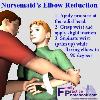Nursemaid's Elbow, Nursemaid Elbow, Pulled Elbow, Radial Head Subluxation
- Definitions
- Nursemaid's Elbow (Radial Head Subluxation)
- Radial head subluxed beneath orbicular ligament
- Epidemiology
- Most common between age 1-3 years
- Rare after 6 years old
- Mechanism
- Symptoms
- Audible snap may be heard with Radial Head Subluxation
- Typically follows mechanism described above
- Signs
- Normal neurovascular exam in classic Nursemaid's Elbow
- Radial Head tender (and may be palpable)
- Arm is held motionless at side
- Slight flexion
- Pronation
- Adduction
- Imaging
-
Elbow XRay Normal
- Not required in a classic Nursemaid's Elbow presentation
- Indications for XRay
- Trauma or fall
- Suspected Nonaccidental Trauma
- Elbow localized Bruising or swelling
- Failed reduction (see below)
- Management
- Reduction
- Contraindications to Reduction
- Positioning (same for both techniques)
- Caregiver holds child on their lap
- Child's affected elbow at 90 degrees
- Examiner stabilizes affected elbow with their directly opposite hand
- Examiner cups the olecranon in their palm
- Examiners thumb applies pressure at the radial head (with thumb in antecubital fossa)
- Examiner grasps the patient's wrist with their other hand
- Apply slight longitudinal traction with the hand grasping the patient's wrist
- Technique 1: Hyperpronation
- Technique 2: Supination and Flexion
- Signs of successful reduction
- Palpable click felt with reduction
- Child begins using the elbow in the subsequent 15-30 minutes
- Management
- Post-Reduction
- Perform neurovascular exam
- Child uses arm within 10-15 minutes
- Immobilization optional (Sling for 1-2 days)
- Child fails to use arm after 15 minutes
- Obtain Elbow XRay to rule out concomitant Fracture
- Elbow XRay normal but child still not using arm
- Posterior splint and sling with elbow at 90 degrees
- Re-evaluate in 24 hours
- References
- Warrington (2023) Crit Dec Emerg Med 37(2): 16-7
- Claudius, Sacchetti and Seiden (January, 2024) EM:Rap
- Macias (1998) Pediatrics 102(1): e10 [PubMed]
